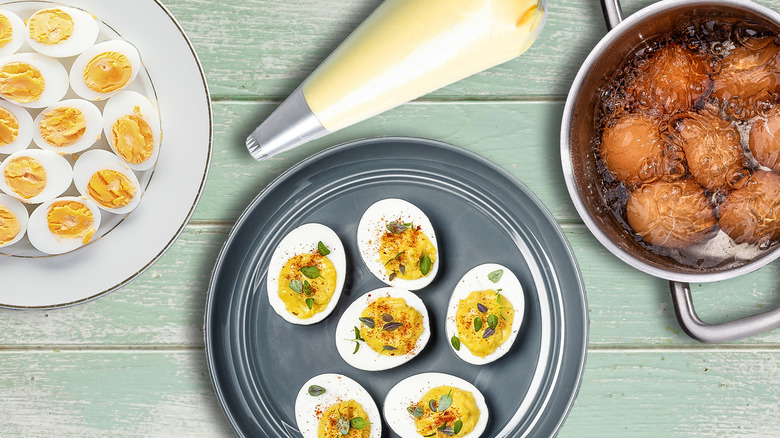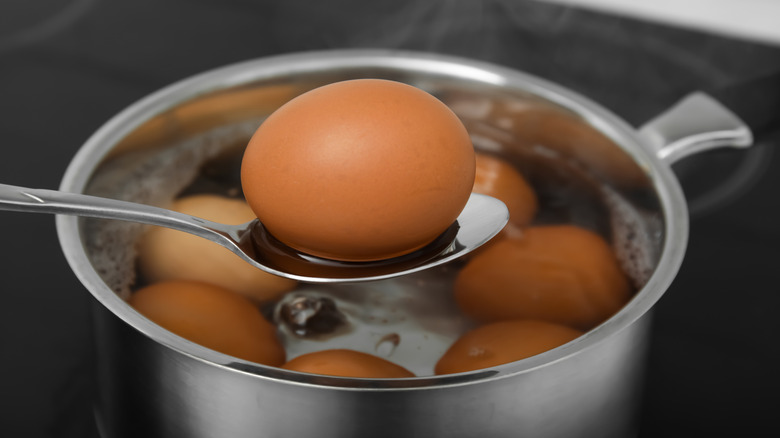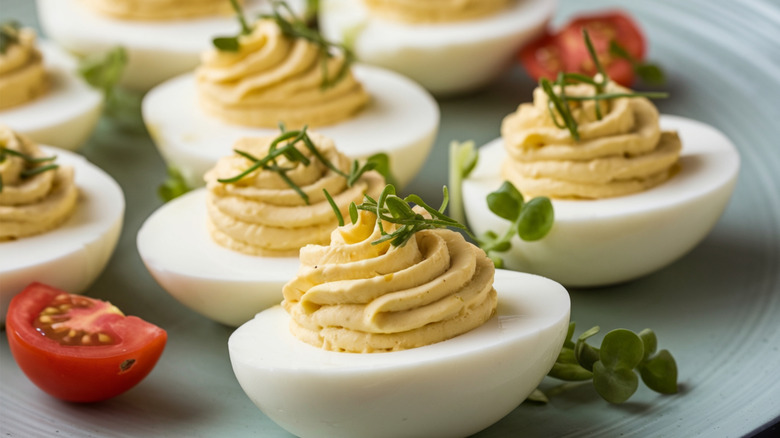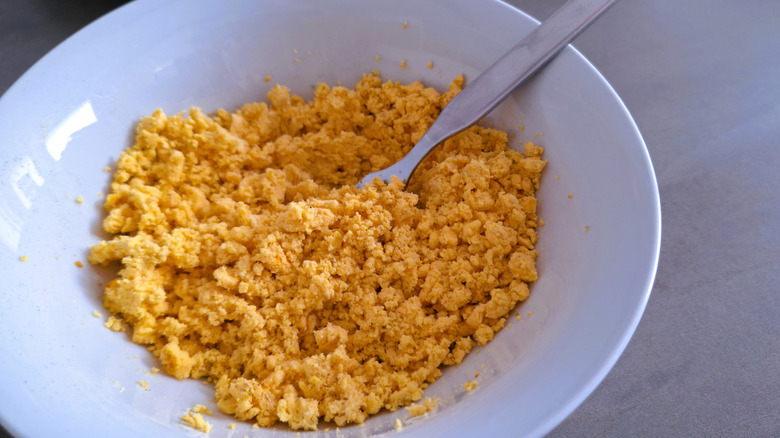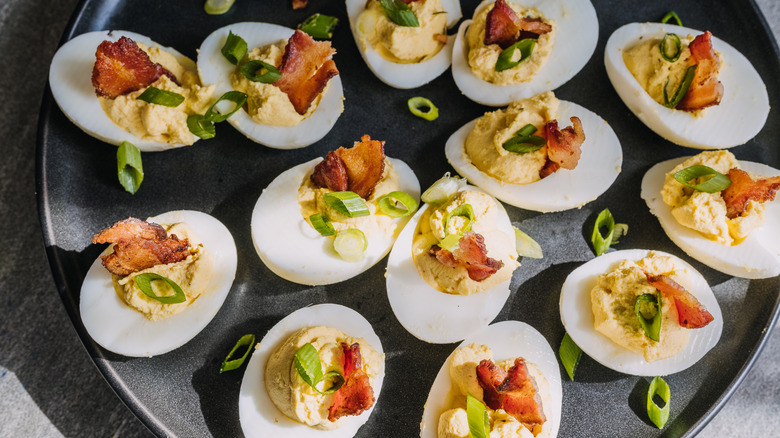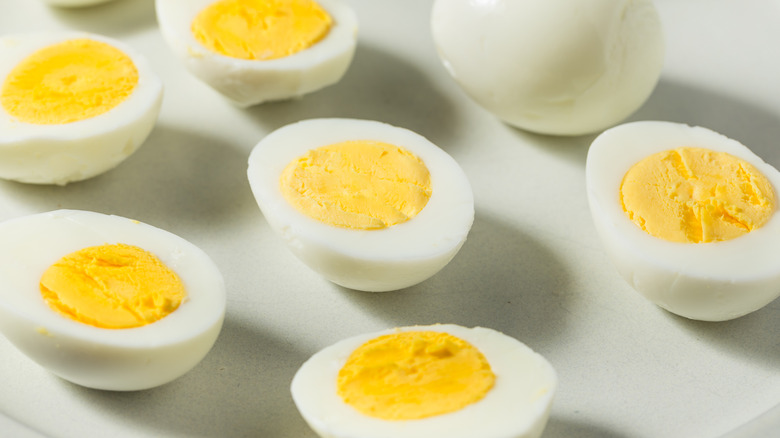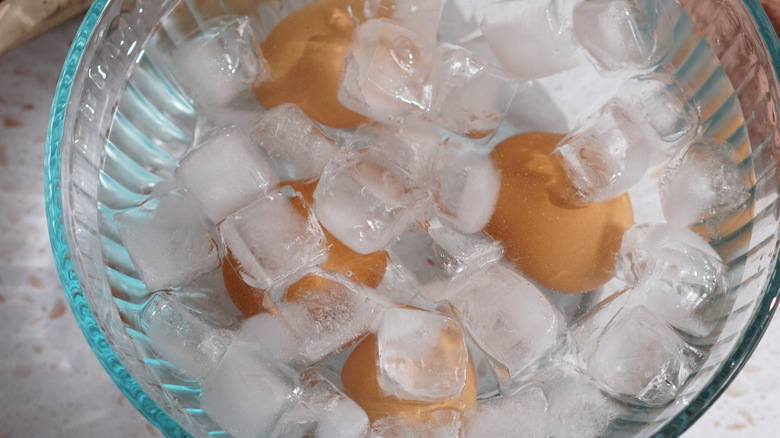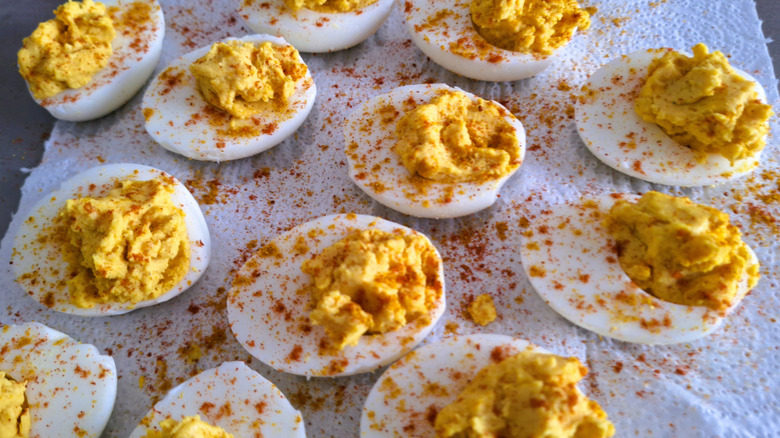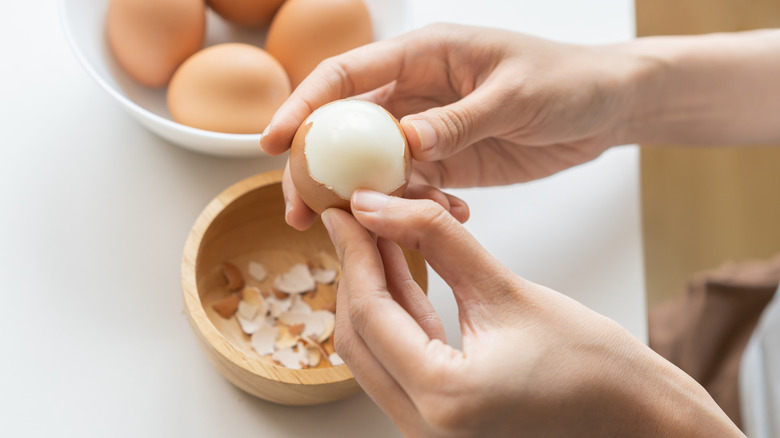10 Mistakes You're Making With Deviled Eggs
Whether you're throwing a party and want to ensure that your guests have plenty to eat or you're just making some fancy snacks to enjoy at home, deviled eggs can do the trick. Sure, they may just be an upgraded version of boiled eggs, but that's exactly why we love them: The texture of the egg whites combined with the creamy richness of the filling makes for a delicious bite-sized (or, okay, two bite-sized) appetizer. And although they can take some time to prepare, they're a relatively simple, straightforward dish to make, even if you're not the world's greatest home cook.
But, although deviled eggs are fairly simple, there are still several common pitfalls that can really mess up your final product. We've collected this list of some of the most common mistakes people make when preparing deviled eggs so you can be sure to avoid them. Read on if you want your deviled eggs to turn out perfectly every single time. Get ready to seriously upgrade your hors d'oeuvre game.
1. Overcooking the boiled eggs
Perhaps the biggest — and maybe the most egregious — mistake that home cooks make with their deviled eggs is overcooking them. Boiling an egg seems like the easiest task in the world, but in reality, it's one of the most finicky aspects of making the dish. And if you leave those eggs in boiling water for just a bit too long, you may get egg whites that have a grayish tinge to them with a rubbery texture that absolutely does not make for a delicious egg. Our advice? Cover the eggs with water in a pot, then bring the water to boil. Once it comes to a rolling boil, you can then take the eggs off the heat, covering the pot and letting them sit in the hot water for about 10 minutes. After the 10 minutes is up, you can put them in an ice bath to cool them down before finally peeling them.
This trick results in perfectly cooked hard-boiled eggs that have a yolk that's firm enough to make a base for the flavorful filling but without rubbery, overcooked whites. Although it may be easier to just boil the eggs until you remember to take them off the heat, being a bit more intentional with your cook times can be the difference between subpar and deeply delicious deviled eggs.
2. Dropping the eggs directly into the pot
There's one super easy way to ensure that your hard-boiled eggs come out of the shell looking messy and uneven, and that's breaking the shell during the boiling process. Once the shell of your eggs breaks, little pieces of egg whites will solidify and float into the water, creating a mess and, often, misshapen egg whites. And, unfortunately, dropping eggs directly into the pot filled with water is quite likely to make them crack. So, how do you stop that from happening without having to dip your fingers in boiling water?
That's easy. You're just going to want to use a spoon or tongs to gently place the egg into the hot water. This essentially ensures that you're not going to drop the egg on the bottom of the pot too hard, resulting in a messy egg white situation. Take the extra couple of seconds to cook your eggs this way, and you'll never have to throw away an egg just because of a broken shell again.
3. Not using enough seasoning in the filling
Deviled eggs are largely about texture, of course, with that lovely contrast of the firm egg white and the creamy yolk. But it's not just about texture and texture alone — you need to incorporate lots of flavor as well if you want to make the most delicious deviled eggs possible. And because you're not getting much flavor from the egg whites, that means that the filling has to pack a lot of punch. One mistake that home cooks often make is not adding enough seasoning to the filling.
Of course, you'll include the egg yolks in the filling, but you'll also want to include ingredients like mustard, mayonnaise, salt, and pepper. Once you add in those ingredients, you can taste your filling and then add other ingredients to amp up the flavor to your liking. Some recipes call for pickle relish, for example, which can make for a bolder, more acidic flavor profile. Others may call for inclusions like vinegar or even finely chopped shallots or chives. Stick to these rather classic add-ins, or get creative with other ingredients and spices you already have in your kitchen.
4. Making a lumpy filling
Have you ever bitten into a deviled egg expecting a smooth, creamy texture from the filling only to discover a less-than-appetizing lumpiness instead? If so, you're not alone — it's happened to the best of us. But if you want to ensure that you're making the most delicious deviled eggs possible, it's imperative to avoid a lumpy filling. The first step you can take in preventing this mistake is making sure that you don't overcook your eggs, which can result in a clumpier yolk texture.
Other than avoiding overcooking your eggs, though, you really just have to make sure you're combining all the ingredients for the filling very well. Really break those yolks down before you add any other ingredients to the mix, and then once you do add in those wet ingredients, mix or whisk them until they're fully incorporated with the egg yolks. Not only will this guarantee a lump-free texture, but it'll also mean that the flavors are uniform and well-integrated throughout your deviled egg filling.
5. Forgetting to include a garnish
Plain deviled eggs are fine, but if you really want to make standout deviled eggs, it's a good idea to include a garnish – there are plenty of other things besides paprika that you can top your deviled eggs with. Garnishes are there for two different reasons. Firstly, they generally add a pop of color or visual interest to make the appetizer look more attractive and appealing. Secondly, and perhaps more importantly, they're there to add even more flavor to the snack.
Luckily, there are a ton of different garnishes you can work with when you're preparing deviled eggs. One of the most common garnishes for this appetizer is a simple sprinkle of paprika, which provides the dish with a lovely earthiness along with a pop of bright, bold color. Similarly, a powdered Bloody Mary mix or chili lime seasoning can make for a bold deviled egg topping.
You don't have to stop with the seasonings, though. Consider adding bacon for some extra richness and fattiness, or adorn your deviled eggs with some chives for that onion-like sharpness. Smoked salmon and capers can make your deviled eggs feel just a bit fancier (and a bit more filling), while black sesame seeds can offer the dish a lovely, subtle nuttiness that looks as good as it tastes. Don't be afraid to experiment with other, more creative garnish options the next time you make deviled eggs.
6. Neglecting to make extra eggs just in case
Of the many mistakes you can make while cooking deviled eggs, neglecting to make enough of them may be one of the most frustrating, especially if you're running short on time. After all, making deviled eggs can be a relatively quick process, but it takes significantly more time if you have to stop to make new, fresh eggs because the ones you originally made fell apart while you were peeling them. Let's be honest — not every boiled egg is going to come out of its shell perfectly, with no nicks, blemishes, or structural imperfections. But by boiling a few extra eggs, you can ensure that you're not going to be short on whites once you're ready to add the filling.
Worried you're going to waste boiled eggs by making too many of them at once? No worries. Cooked boiled eggs can last for a few days in the fridge, so you can simply enjoy them the next day for breakfast if you don't end up including them in your deviled egg spread.
7. Forgetting to chill the eggs after you cook them
There are times when it's easy to get impatient in the kitchen, especially when you're running low on time or are feeling really hungry and just want to dig into the dish you're making. However, that doesn't mean you should skip the chilling step when you're making deviled eggs. After you take the boiled eggs out of the hot water, they should spend some time in an ice bath. This is an important step first and foremost because chilling the eggs before peeling them makes them a lot easier to peel cleanly, without pulling off chunks of the egg whites with the shell.
Another good reason to let those eggs cool down before adding the filling to the egg whites is because hot egg whites can make the filling too loose and melty, resulting in a messy appetizer that's hard to eat without a fork or without making a mess.
8. Not cutting the eggs lengthwise
Most people who make deviled eggs understand that you have to cut the egg in half in order to remove the yolk, make the filling, and create those perfect egg white halves. But you're going to want to pay close attention to the way in which you cut your eggs in half. Remember to always cut lengthwise, creating two equal, longer egg halves instead of shorter, deeper whites. First and foremost, this makes for deviled eggs that are easier to eat, since the "cups" won't be quite so deep. Secondly, it allows you to present more uniform deviled eggs that look better when you present them on a plate.
For some home cooks, this may seem like a no-brainer. But to the uninitiated deviled egg maker, it's an all too common mistake. By making sure you're cutting your eggs in the right direction, you'll get a perfect bite every time.
9. Using a spoon instead of a piping bag to fill the eggs
Generally, we don't think you need a bunch of fancy kitchen stuff to address most basic cooking problems. More often than not, the simple tools you already have in your kitchen will get the job done without too much of a fuss. And if you have a similar perspective, then you may assume that all you really need to fill your deviled eggs with is a regular old spoon. Of course, that will get the job done in a pinch, especially if you don't particularly care about how the eggs end up looking. (And honestly, especially if you're just making them for yourself, that's totally valid.)
But when you want your deviled eggs to look a bit more attractive, it can pay to use a piping bag for the filling. By piping that filling directly into the egg whites, you can create a pretty swirl pattern that'll draw your guests' eyes immediately. You can even use fancy piping tips if you really want to make your eggs shine. If you use a spoon, on the other hand, you're likely to have messier results, without that picture perfect appearance you'd expect from restaurant-quality deviled eggs. Yes, both methods work, but deviled eggs made with a piping bag are sure to look cleaner.
10. Not being careful when peeling the eggs
If you're in a rush to get your deviled eggs on the table as soon as possible, then you may rush through certain steps of the process — especially when it comes to more finicky, time-intensive ones like peeling the boiled eggs. However, it's a mistake not to be careful when you're peeling, since it's so easy to remove chunks of egg whites as you take off the shell. This can lead to your deviled eggs looking chunky and patchy, without the smooth firmness that makes this appetizer so texturally appealing.
One way to ensure perfectly peeled boiled eggs is to give the eggs an ice bath right after you remove them from the boiling water. You can also try adding some white vinegar to the water you're boiling your eggs in, which will also make for a simpler peeling process. Most importantly, though, you should take your time while peeling, making sure you get every speck of shell without removing any of the egg white in the process.
